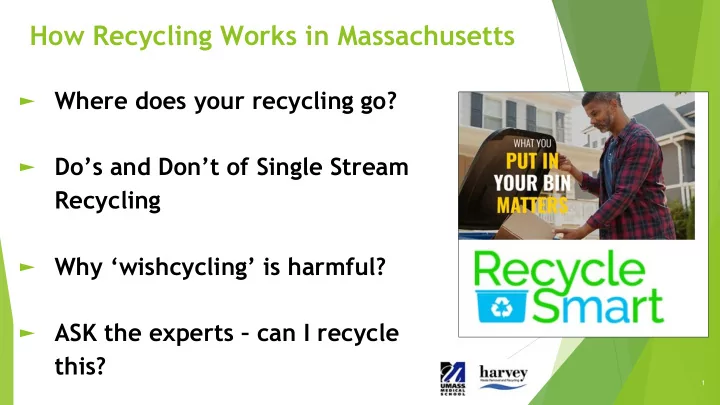

How Recycling Works in Massachusetts ► Where does your recycling go? ► Do’s and Don’t of Single Stream Recycling ► Why ‘wishcycling’ is harmful? ► ASK the experts – can I recycle this? 1
Introduction Suzanne Wood, LEED AP Associate Director, Sustainability and Campus Services, UMass Medical School Mary Martin Resource Manager E.L. Harvey 2
Where does your single stream go? ► All single stream recycling is taken to a the material recovery facility (MRF) where the trash is removed and the recyclable materials are sorted and baled. ► What is accepted at you workplace may be different than what is accepted at home since the recyclable may go to different MRFs to be sorted. ► At EL Harvey there are separate MRFs for residential and industrial single stream because the mix of recyclable materials is different so the sorting process is different ► Since residential single stream recycling facility is heavily automated, it is essential that the “rules” are followed to prevent contamination and equipment failures 3
Materials to recycle: 4
Do’s of Residential Recycling What goes in the bin – paper, newspaper, cardboard, clean rigid plastic, cans, clean aluminum, clean bottles. Think containers – food or product that you purchase from the store & now that container is empty. Rinse containers ► The ketchup, salad dressing, mayonnaise, or cat food you left in the bottom of their respective containers, will fly out when it hits a sorter’s rotors, splattering the nearby recyclables. It will turn a bale of paper into “the blob”. Plus, food gets moldy & can make paper moldy, especially sitting around in the heat. Please, rinse out your container! Leave the caps on ► Bottles act as transporters for caps - during the recycling process, loose caps/lids will end up in trash anyway because of their size .Improved technologies for sorting plastic make it easier to separate the different materials and when glass gets recycled, it gets crushed into little pieces & the non-glass material is sorted out. Don’t crush the bottles ► It makes it easier for the machines to sort bottles and cans 5
The Don’t of Residential Recycling 6
The Don’t of Residential Recycling PLASTIC BAGS ► grocery bags, dry-cleaning bags, plastic that protects your newspaper, trash bags, any kind of “soft” plastic - #1 problem at the recycling plants – they catch on the rotors and jam the mechanical sorters. Workers must shutdown machinery & cut them out by hand, which is dangerous & costly. Most of your grocery stores have collection bins TANGLERS ► Similar to plastic bags, anything that can get tangle in the machinery – wire hangers, holiday lights, cords of any sort, computer cables, garden hoses – you get the drift! STYROFOAM ► Any foam item – cups, egg cartons, packing material belongs in the trash – it is not plastic & it is not paper so it does not belong in single stream. TEXTILES ► Clothing, shoes, sheets, towels – these items can be reused, but are not recycled via single stream. These items will get banished to a landfill and 7
The Don’t of Residential Recycling Cont. MIXED MATERIALS ► Foam-lined cardboard boxes, mailing envelopes with bubble wrap – recycling processors do not have equipment to separate the two items from each other. Paper cartons that hold milk, juice, and broth can be lined with wax, plastic, or aluminum and to-go coffee cups are lined with plastic. PRESSURIZED CONTAINERS ► Aerosol containers, propane tanks, helium tanks – these can explode from the pressure of the machinery. Aerosol cans be put in the trash. Check your local municipal website to dispose of tanks. PAPER NAPKINS/TOWELS, TISSUES (used or unused) ► The material in these items have been recycled many times & are at the end of their recycled life. Also, these items could have come in contact with food waste, grease, and possibly bodily fluids, so they can potentially contaminate the whole recycling cycle at the recovery facility. SHREDDED PAPER ► Shredded paper is “dreaded paper” at the material recovery facility. It either ends up floating all over the place like confetti or, if it gets wet, it turns into pulp. Either way it isn’t captured for recycling. Therefore, we say Please No shredded paper in the recycling. 8
How “wishcycling” hurts harms recycling What is Wishcycling? ► Aspirational recycling - when people put something into the recycling bin without checking whether it's actually recyclable or accepted by their hauler. They don't want to add more waste to the planet, so they toss your item in the recycling bin, hoping it'll get recycled This well-intentioned action is doing more harm than good ► These non-recyclable items are being sorted out at the MRF, but this adds to the cost of recycling - both economical and environmental. ► Non-recyclable items that slip through are causing contamination, making it harder for facilities to achieve contamination rates below (0.5%) which China and other countries now require If you really want to reduce waste, consider how your good are packaged and use reusable items instead of disposables where possible. 9
The best thing you can do to encourage recycling is to focus on recycling the right thing! 10
ASK THE EXPERTS...Is this recyclable? 11
Recommend
More recommend